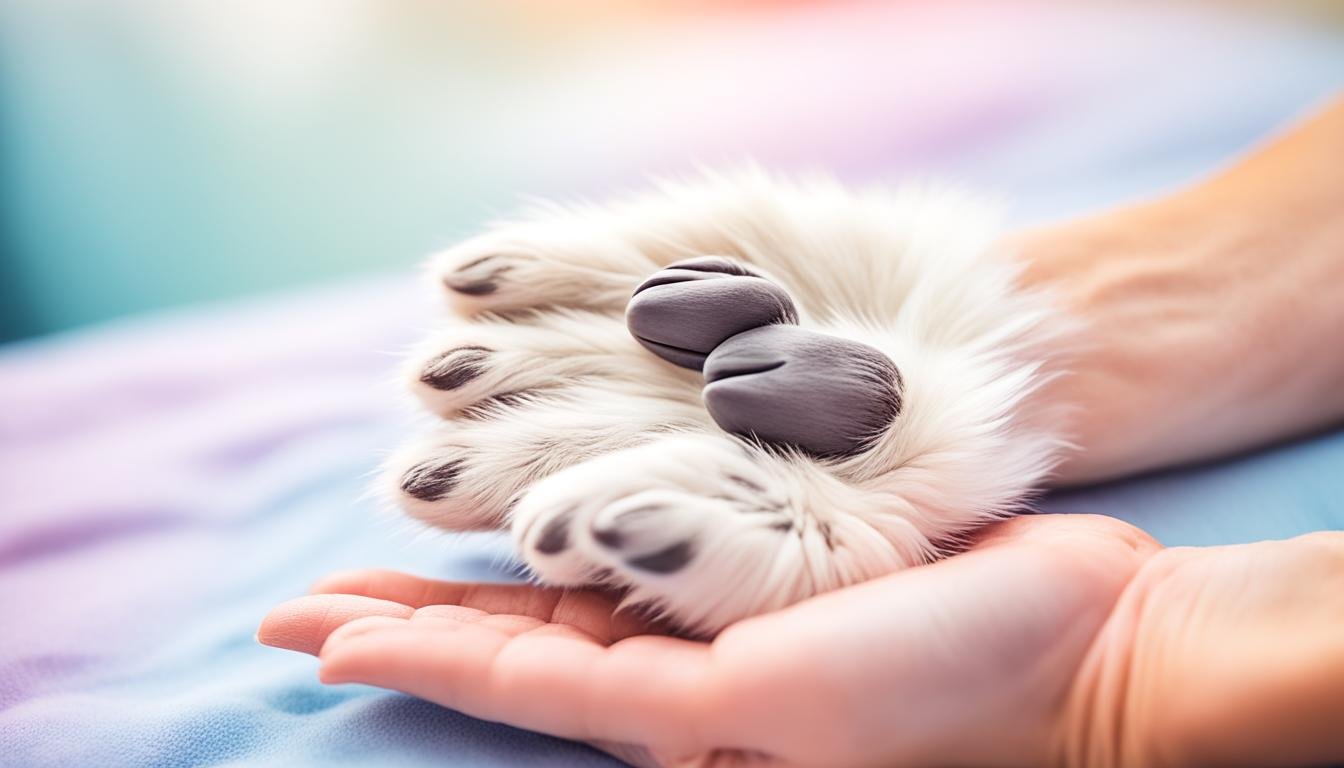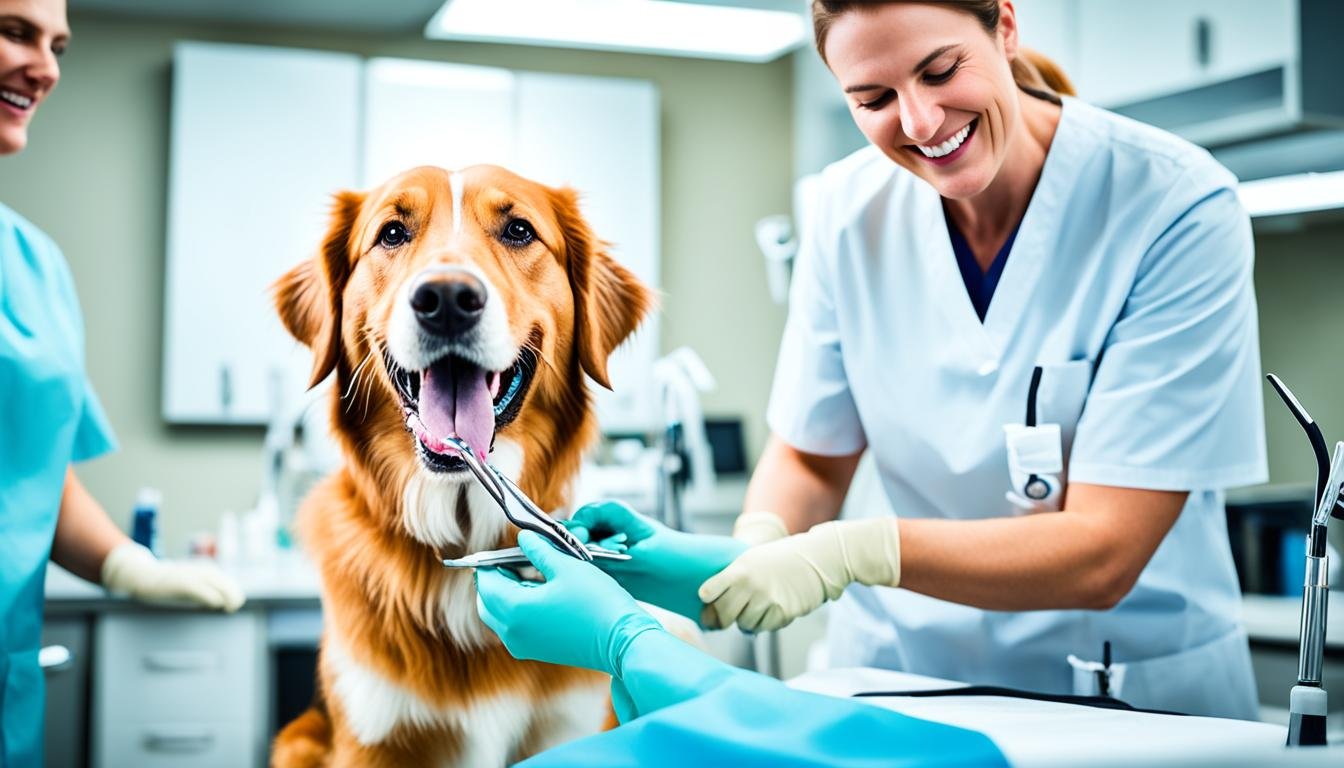Welcome to our comprehensive guide on pet rehabilitation therapy! If your furry friend has suffered an injury or is experiencing mobility issues, pet rehabilitation therapy can be a valuable solution. Through animal physical therapy and targeted pet rehabilitation exercises, you can help your pet regain their strength, mobility, and overall well-being.
In this article, we will explore the world of pet rehabilitation therapy, discussing its benefits and various techniques. We will also provide insights into designing a personalized pet rehabilitation program and offer tips for ensuring success throughout the recovery process.
Understanding Pet Rehabilitation Therapy
In the world of veterinary medicine, pet rehabilitation therapy plays a vital role in aiding the recovery of our furry companions. Whether it’s assisting in the healing process of a pet injury rehabilitation or improving mobility in older pets, this specialized therapy focuses on enhancing your pet’s quality of life.
One of the key components of pet rehabilitation therapy is veterinary rehabilitation services. These services are provided by trained professionals who specialize in animal physical therapy. They work closely with veterinarians to develop personalized treatment plans that address the specific needs of each pet.
Pet rehabilitation therapy is particularly beneficial for pets recovering from injuries. Just like humans, animals can experience a range of injuries, including fractures, muscle strains, and joint sprains. Through a combination of pet rehab techniques, recovery can be accelerated and pain can be minimized.
Several pet rehab techniques are commonly employed in pet rehabilitation therapy. These techniques are designed to improve strength, flexibility, and coordination, promoting faster healing and rehabilitation. Some examples include therapeutic exercises, manual therapy, hydrotherapy, and electrical stimulation.
In the next section, we will explore the numerous benefits of pet rehabilitation therapy in more detail, including how pet mobility exercises can greatly enhance your pet’s well-being.
Key Components of Pet Rehabilitation Therapy
| Veterinary Rehabilitation Services | Pet Injury Rehabilitation | Pet Rehab Techniques |
|---|---|---|
| Professional guidance and expertise in animal physical therapy | Specialized treatment plans for injured pets | Therapeutic exercises, manual therapy, hydrotherapy, and electrical stimulation |
| Collaboration with veterinarians for comprehensive care | Accelerated recovery and pain management | Improved strength, flexibility, and coordination |
The Benefits of Pet Rehabilitation Therapy
Pet rehabilitation therapy offers numerous advantages for your beloved furry friend. Through a combination of pet mobility exercises, canine rehabilitation therapy, and feline physical therapy, your pet can experience enhanced well-being and improved quality of life.
Enhancing Mobility with Pet Mobility Exercises
Pet mobility exercises play a crucial role in improving your pet’s ability to move and function. These exercises not only strengthen muscles and improve joint flexibility but also aid in alleviating pain and discomfort caused by various conditions such as arthritis, injuries, or post-surgical recovery.
By engaging in regular pet mobility exercises, such as walking on uneven surfaces, low-impact resistance training, and balance exercises, your pet can regain and maintain their mobility, allowing them to lead a more active and fulfilling life.
Canine Rehabilitation Therapy: Specific Advantages for Dogs
Canine rehabilitation therapy is designed to address specific needs and challenges faced by dogs. Whether your furry companion is recovering from an injury, suffering from a degenerative condition, or preparing for a surgery, canine rehabilitation therapy can greatly benefit them.
With the help of skilled therapists, your dog can undergo a tailored treatment plan that may include hydrotherapy, underwater treadmill exercises, agility training, and more. These techniques can improve strength, balance, coordination, and overall physical performance.
Feline Physical Therapy: Tailored Care for Cats
Feline physical therapy recognizes the unique nature and needs of cats, ensuring that they receive proper care and rehabilitation. Cats may require physical therapy due to aging, injuries, surgical procedures, or conditions that affect their mobility.
Through feline physical therapy, cats can enjoy gentle exercises, stretching, balance training, and other techniques that cater to their specific needs. These therapies can help alleviate pain, improve flexibility, increase muscle strength, and enhance their overall well-being.
By integrating pet mobility exercises, canine rehabilitation therapy, and feline physical therapy into your pet’s recovery journey, you are providing them with the opportunity to regain their independence, joy, and comfort.
| Benefits of Pet Rehabilitation Therapy: |
|---|
| Enhanced mobility |
| Pain relief and reduction |
| Improved muscle strength and flexibility |
| Increased joint mobility |
| Enhanced overall well-being |
Common Techniques in Pet Rehabilitation Therapy
When it comes to pet rehabilitation therapy, there are various techniques that are employed by animal physical therapy specialists to help pets recover and regain their mobility. These pet rehab specialists play a crucial role in guiding the treatment process and ensuring an effective recovery for your furry friend.
Animal Physical Therapy Specialists
Animal physical therapy specialists are highly trained professionals who specialize in providing rehabilitative care for pets. They have a deep understanding of the musculoskeletal system of animals and employ specific techniques to address injuries and improve mobility. These specialists work closely with veterinarians to design personalized treatment plans tailored to the unique needs of each pet.
Some of the common techniques used in pet rehabilitation therapy include:
- Therapeutic Exercises: These exercises are designed to strengthen muscles, improve range of motion, and enhance overall mobility. They may include activities such as gentle stretching, balance exercises, and controlled walking or swimming.
- Manual Therapy: Manual therapy techniques, such as massage and range of motion exercises, are used to alleviate pain, reduce muscle tension, and improve joint flexibility. These hands-on techniques can help pets relax and promote healing.
- Electrotherapy: Electrical stimulation and ultrasound therapy are commonly used in pet rehabilitation therapy to alleviate pain, promote tissue healing, and reduce swelling. These modalities can accelerate the recovery process and provide relief to pets experiencing discomfort.
- Hydrotherapy: Hydrotherapy involves the use of water as a therapeutic medium to aid in rehabilitation. Under the guidance of a pet rehab specialist, pets may undergo water treadmill sessions or swimming exercises to improve muscle strength, joint mobility, and cardiovascular fitness.
- Assistive Devices: In some cases, assistive devices such as braces, slings, or wheelchairs may be used to support and stabilize pets during their rehabilitation journey. These devices help pets regain mobility and independence, enabling them to move comfortably.
By employing these techniques, pet rehab specialists strive to improve the physical well-being and quality of life of pets recovering from injuries or struggling with mobility issues.
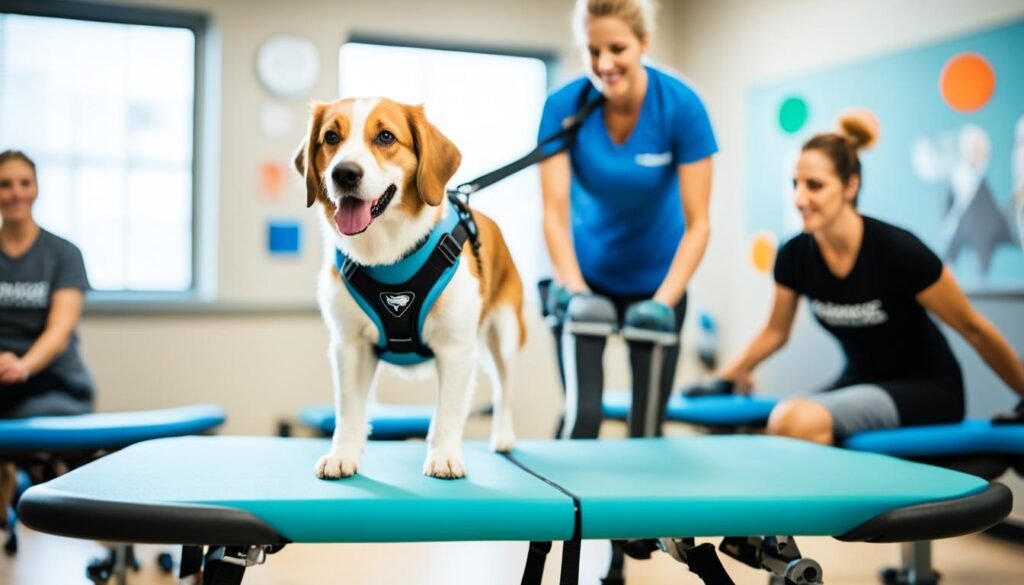
Expert Insights
“Pet rehabilitation therapy offers a wide range of techniques to help pets regain their mobility and overcome physical challenges. From therapeutic exercises to innovative modalities, the goal is to optimize their recovery and enhance their overall well-being.”
– Dr. Sarah Mitchell, Animal Physical Therapy Specialist
| Technique | Description |
|---|---|
| Therapeutic Exercises | Exercises designed to improve strength, range of motion, and mobility. |
| Manual Therapy | Hands-on techniques such as massage and range of motion exercises. |
| Electrotherapy | Electrical stimulation and ultrasound therapy to promote healing and pain relief. |
| Hydrotherapy | Water-based exercises to improve muscle strength and joint mobility. |
| Assistive Devices | Braces, slings, or wheelchairs to support pets during their rehabilitation. |
Designing a Pet Rehabilitation Program
When it comes to helping your furry companion regain their mobility and overcome injuries, designing a personalized pet rehabilitation program is key. By tailoring the treatment plan to suit your pet’s specific needs and condition, you can optimize their recovery process. In this section, we will walk you through the crucial steps involved in creating an effective pet rehabilitation program, ensuring your furry friend receives the best care possible.
One of the fundamental aspects of designing a successful pet rehabilitation program is seeking the expertise of veterinary rehabilitation services. These professionals specialize in providing comprehensive care and guidance throughout the rehabilitation journey. With their in-depth knowledge of animal anatomy and physiology, they can develop a customized plan that addresses your pet’s unique challenges.
To give you an idea of what a pet rehabilitation program may entail, here are a few examples of pet rehabilitation exercises that can be incorporated into your pet’s routine:
Underwater Treadmill Therapy:
This technique involves your pet walking or running on a treadmill submerged in water. The buoyancy of the water reduces joint stress and provides gentle resistance, aiding in strengthening muscles and improving coordination.
Therapeutic Ultrasound:
By utilizing high-frequency sound waves, therapeutic ultrasound can promote tissue healing, alleviate pain, and reduce inflammation. This non-invasive technique can be beneficial for pets suffering from musculoskeletal conditions.
Range of Motion Exercises:
These exercises aim to increase your pet’s joint flexibility and prevent stiffness. Simple range of motion movements, such as gently stretching the limbs, can promote better mobility and reduce the risk of further injury.
Remember, every pet rehabilitation program should be tailored to your pet’s specific needs under the guidance of a veterinarian or licensed animal physical therapist. These professionals will assess your pet’s condition and recommend appropriate exercises and treatments to facilitate their recovery process. As your pet progresses, the program may be adjusted to ensure continual improvement and optimal results.
By following a personalized pet rehabilitation program, you can play an active role in your furry friend’s journey towards healing and improved mobility. The combination of veterinary rehabilitation services and targeted pet rehabilitation exercises will provide your pet with the best chance of regaining their independence and enjoying a happy, active life once again.
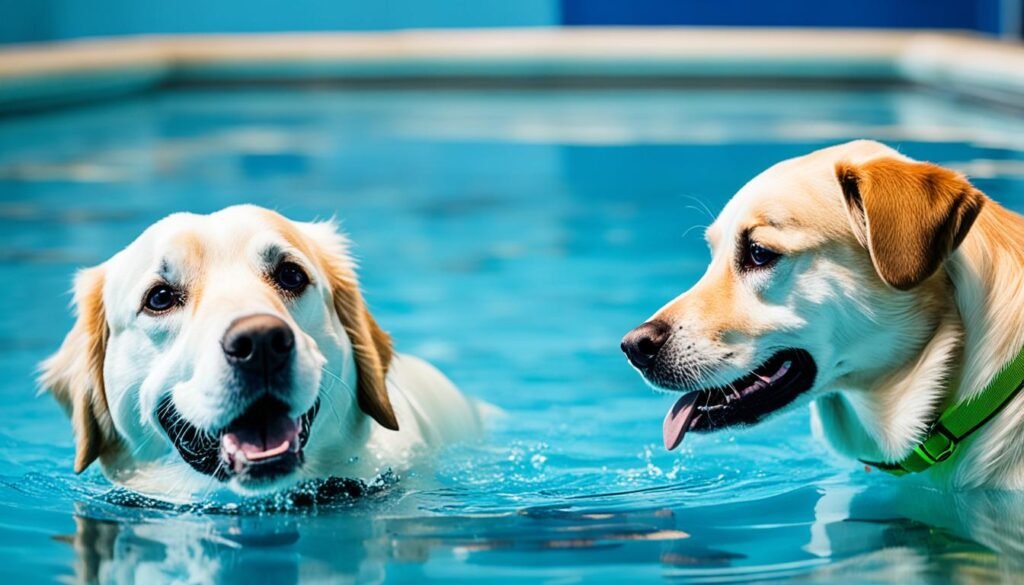
Ensuring Success in Pet Rehabilitation Therapy
When it comes to pet rehabilitation therapy, success is not only measured by the recovery of your furry friend but also by the quality of care they receive throughout the process. To ensure the best possible outcome, it’s essential to enlist the expertise of pet rehab specialists who can guide you and your pet towards optimal healing.
Pet rehab specialists are trained professionals who specialize in pet injury rehabilitation and are equipped with the knowledge and skills to address a wide range of musculoskeletal conditions. With their expertise, they can assess your pet’s condition, formulate a personalized treatment plan, and monitor their progress closely.
One of the key aspects of ensuring success in pet rehabilitation therapy is addressing and treating pet injuries effectively. By identifying the root cause of the injury and developing targeted rehabilitation techniques, pet rehab specialists can help alleviate pain, restore mobility, and promote faster healing.
Canine rehabilitation therapy is particularly important in the success of pet rehabilitation. Dogs, being active animals, often require specialized therapy to target their specific needs and enhance their recovery. Through a combination of targeted exercises, hydrotherapy, and other rehabilitation techniques, canine rehabilitation therapy can significantly improve your dog’s mobility and overall well-being.
To summarize, working with pet rehab specialists, addressing and treating pet injuries effectively, and incorporating canine rehabilitation therapy are crucial steps in ensuring the success of your pet’s rehabilitation journey. By following these strategies, you can provide your furry friend with the best possible care and help them regain their vitality and happiness.
| Strategies for Success in Pet Rehabilitation Therapy |
|---|
| Seek the guidance of pet rehab specialists |
| Address and treat pet injuries effectively |
| Embrace canine rehabilitation therapy |
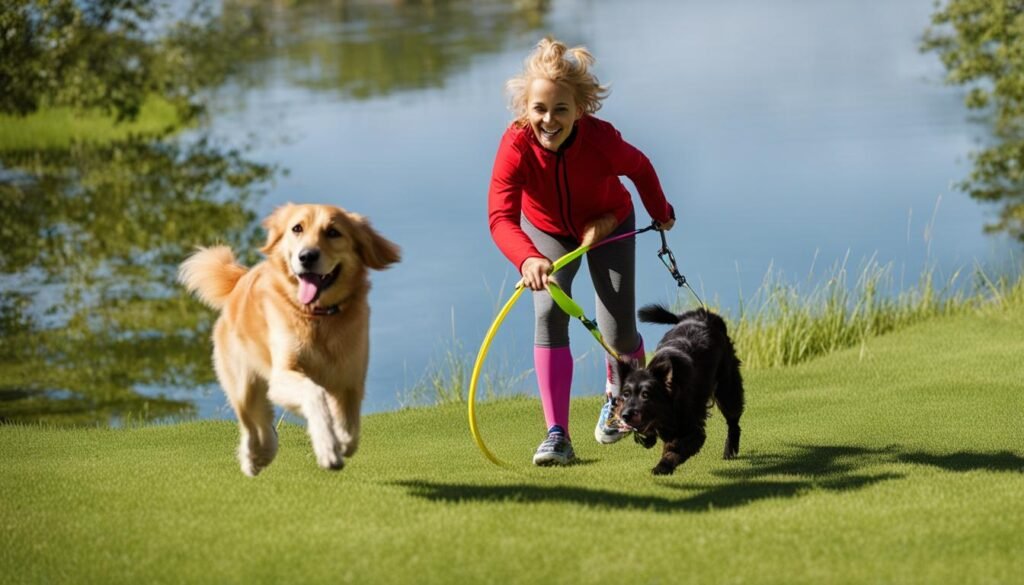
Transforming Pain into Comfort
When our beloved pets experience pain and discomfort, it can be heart-wrenching to witness. However, with the power of pet rehabilitation therapy, we can help transform their suffering into comfort and improve their overall quality of life. By incorporating pet mobility exercises and various pet rehab techniques, we can provide much-needed relief and aid in their healing process.
Pet rehabilitation therapy focuses on restoring and enhancing the mobility and function of our furry companions. Whether they are recovering from an injury or managing a chronic condition, this therapy offers a holistic approach to their rehabilitation journey. Through a combination of targeted exercises and specialized techniques, pets can regain their strength, flexibility, and independence.
One of the key components of pet rehabilitation therapy is the introduction of pet mobility exercises. These exercises are designed to address specific areas of weakness or immobility, targeting the muscles, joints, and overall physical well-being of our furry friends. From gentle stretching to dynamic movements, these exercises can help pets build strength, improve balance, and alleviate pain.
Additionally, pet rehab techniques play a vital role in their recovery. From hydrotherapy and therapeutic ultrasound to acupuncture and massage, these techniques are administered by trained professionals to enhance the effectiveness of the rehabilitation process. By understanding and utilizing the right combination of techniques, pet rehab specialists can tailor a treatment plan that suits the unique needs of each individual pet.
